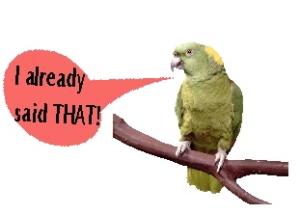Blog
Echolalia
What is Echolalia? Echolalia, if you aren’t familiar with the term, is when an individual repeats what he/she has heard. It is often associated with ASD (Autism Spectrum Disorder). There are two types of echolalia: immediate and delayed. Immediate echolalia is when the child repeats what you just said or what he/she just heard. Delayed echolalia is when the child repeated things heard in the past— this is typically when individuals are repeating scripts from movies/shows. Echolalia can be appropriate or inappropriate for the situation but involves sentences or phrases of language with the same intonation (pitch) that occurred when the child originally heard it.
What Causes Echolalia? Certain forms of ASD (autism spectrum disorder) can cause echolalia. Some people will experience it when they are stressed or anxious while others experience it on a consistent basis. Echolalia is a natural part of learning but it subsides after a certain age. Many children are able to develop their own thoughts as they continue to grow up, while others will continue to use echolalia.
What are Symptoms of Echolalia? The main symptom of echolalia is repetitions and imitation of language/noises. For instance, a child with echolalia will repeat a question instead of answering it. Other signs of echolalia include depression, muteness, and frustration during conversations.
What are the different communicative purposes for a child with echolalia
1. Conversational and turn taking: The child realizes that a conversation requires a response in return. Therefore, he is aware that he must answer after his conversational partner has spoken. The child generally lacks the expressive language to communicate and will therefore use echolalic speech in order to respond.
2. Initiation of communicative interactions: The child is starting to recognize and notice others in his surroundings. Due to the fact that he/ she lacks the language to comment he/she will use echolalic language.
3. Requesting: A child may use echolalic utterances to requests a need, want, or desire. This is usually in the form of a question such as “Do you want to watch television?” This may indicate that he/she wants television.
4.To respond Yes to a question: A child may use echolalic language to respond affirmatively to a question. For instance, a person asks “Do you want a cookie?” The child responds with “Do you want a cookie?” This indicates that he does in fact desire the cookie.
How is Echolalia Diagnosed? Echolalia can be diagnosed through conversation. If a child continuously repeats what he/she has heard this could be have echolalia. In addition, echolalia can range from mild to severe.
How is Echolalia prevented? Echolalia cannot be completely prevented although providing children with a repertoire of words and phrases can help them decrease their echolalia. Echolalia is a part of the natural learning process. Parents can also expose children to other forms of communication during episodes of echolalia.
Tips to use with child who exhibits echolalia?
- Model language from your child’s viewpoint. Model words that your child can understand and use in conversation. For instance, narrating play with your child is very effective because he/she will use it while playing independently and will generalize this modeling to other play situations.
- Do not ask the child questions such as “Do you want…?” since he/she will likely respond with repetition of the question. For this situation, use a verbal model for what you know he/she wants. For instance, “ I want a cookie!” is a good way to provide a verbal model for the child.
- When provided choices for your child do not use questions such as “Do you ______ or _________ that?” It is important to model the choices without using the intonation (pitch) of a question. Also make sure to present both the choices and hold the desired item forward while providing a verbal model.
- Model for a child what he/she might need if he/she needs help. Do not say, “Do you need help with that?” rather use the phrase “Help me!”
- Avoid uses common phrases such as “good boy” or “good job with the child’s name since he/she will often imitate it. A better alternative is smiling, hugging, and varied positive reinforcement to promote good behavior/responses.
Lastly, it is important to note that when a child is using echolalia they are attempting to communicate. Remember, an attempt to communicate it better than no attempt to communicate at all. They are positive qualities with echolalia such as strong memory and learning from repeated patterns. Use these suggestions provided above with your child and ask your speech-language pathologist to help you figure out personal ways to help your child!





